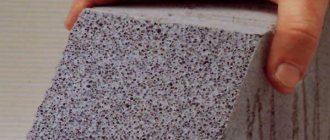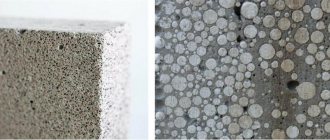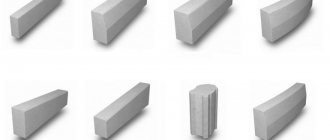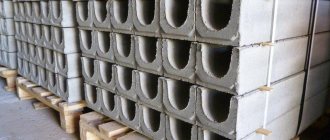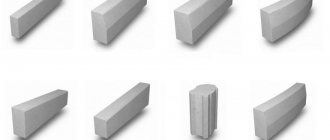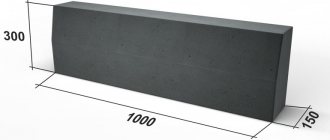Pallets (pallets) are widely used in wholesale and retail trade, as well as in the transportation and storage of goods. Pallets ensure the safety of goods during transportation; otherwise, when driving on uneven roads, they may fall, become deformed and become unusable. You can’t do without them in warehouses or on racks, since they help organize space and move several goods from place to place at once.
Pallets are divided into types according to many parameters. Below are the classifications by material and size.
Ordinary pallets are not marked in any way; they do not have a company mark. The design completely replicates the Euro pallet (same number and arrangement of boards).
We invite you to test your knowledge:
A gift to everyone who answered correctly!!!
Maximum amount of cement per pallet
The capacity and load-carrying capacity of a pallet directly depends on the material from which it is made.
In most cases, wooden products are used. When laying bags of cement, the following features must be taken into account: Based on these data, the maximum number of bags that can be placed on a wooden pallet will be as follows:
But it is better to exclude the presence of residues in advance, since even with proper storage, the shelf life of the material is no more than 1 year. It must be taken into account that every month it loses about 5% of its quality. Therefore, it is important to correctly calculate the required amount of binder. And for this you need to know the volume of a bag of cement.
Volumetric weight of brick
Of course, for those who have started a large construction project and their financial resources are not limited, this figure is not so important. However, for those planning to build a small animal house or woodshed, buying too much material can be a significant problem.
When it comes to how many cubes of brick are in a pallet, there is another way of calculating. You can calculate how many bricks fit in one cubic meter by knowing the size of the briquettes.
- The volume of a single product (25x12x6.5 cm) is 1950 cubic centimeters or 513 bricks per cubic meter.
- The volume of a one-and-a-half piece (25×12×8.8 cm) is 2640 cubic centimeters or 379 bricks.
- The volume of double products (25x12x13.8 cm) is 4140 cubic centimeters or 255 bricks.
How many cubes are in a 50 kg bag of cement?
As you know, volume is determined by the density of the material. The lowest indicator is for freshly ground cement. This is explained by the fact that the particles are magnetized as a result of friction and are located at a distance from each other.
Depending on the strength grade, the bulk density of cement is:
To find out the exact volume of a 50 kg bag of cement, you need to make the following calculations:
That is, from one bag weighing 50 kg, converted to liters, you should get about 38 liters of material.
Some manufacturers indicate bulk density directly on the binder packaging. But after transportation and a certain storage period, it may differ slightly.
Source
Pneumatic unloading of railway tanks (Fig. 3)
Unloading cement from railway tanks using a pneumatic method is similar to unloading road tanks. The railway tank is loaded with cement at the manufacturing plant through hatches in its upper part and moved to the construction site over long distances. After installing the tank at the unloading site, a rotary compressor driven by an electric motor is connected to it.
Compressed air from the compressor, through a distribution device, is supplied to the space of the tank above the layer of material in it and, at the same time, to the space under the air trays installed inside the tank.
The air trays are installed with a slope towards the middle part of the tank and the cement-air mixture formed in the area above the trays begins on both sides to shift towards unloading. Through a hatch in the middle of the tank, cement, separated from the air, enters the collector and from there is unloaded into prepared containers or poured freely.
When pneumatically unloading cement using all the methods described above, an environment of increased dustiness of the working area with harmful cement dust may arise, therefore, personnel must comply with all the requirements of the unloading instructions and strictly adhere to sanitation standards.
How many bags of cement are in a pallet?
Builders are often interested in questions related to working with cement, such as the question: “how much pva should I add to a bag of cement so that the structure is strong and does not crumble?” But this is not the only concern.
When carrying out construction work, it is not known in advance how much material will be needed, and often, fearing a shortage and not wanting to interrupt repair work, builders often purchase the necessary material in excess of the required norm.
This happens in the case of bags of cement. Cement is a durable material for building houses, but at the same time it is very vulnerable, as it is very afraid of moisture.
It is because of this that it has to be stored in special conditions.
Before you find out how many bags of cement are in a pallet, you need to sort out the types of pallets.
Types and strength of pallets
Flat pallets are very convenient for storing and transporting bags of cement.
Pallets are typically small, flat platforms, often made of wood, that make storage and long-distance transportation easier.
How many bags a pallet of cement made from wood contains depends on the quality and strength. In most cases, this is determined by the type of wood from which they are made and the type of processing.
It is also necessary to exclude access to moisture, since the wood from which the carrying equipment is made can rot. It is also worth considering that wooden pallets can be subject to deformation under heavy weight. Therefore, they are not designed to carry multi-ton materials.
In addition to wooden pallets, there are other materials from which they can be made:
Plastic pallets are the most popular, along with wooden ones. Their parameters depend on the strength of the substance from which they are made. Plastic type pallets are lighter than wooden ones, they do not absorb moisture and are more hygienic.
The metal type of pallets is highly durable and is designed for storing and transporting a large mass of cargo compared to wooden and plastic ones. This fact determines that a large number of bags of cement can be stacked on pallets of this type.
Corrugated cardboard pallets are very convenient for air transportation due to their lightness. But at the same time, they are susceptible to moisture. They are also not suitable for long-term storage and transportation, as they can become deformed under heavy weight.
Classification of used pallets
In Europe and Russia, not only new pallets are used, but also used ones, which are divided into three types based on their condition.
- Top grade. These are almost new, clean pallets with no surface damage, and have been used no more than 3 times in their entire history.
- First grade. It is possible that they have been used more than three times, but their appearance must be preserved: clean, original color, smooth surface without damage. It is important that the products have not been repaired, since such intervention implies serious damage.
- Second grade. Minor dirt is allowed, as is darkening of the wooden surface. Damage limit: length 30 cm and width 3 cm. Several pallets that have been repaired are allowed.
Pallet capacity
Thus, the question: “How many bags of cement can fit on a pallet?” can be answered by knowing the material and strength from which the pallet is made, as well as taking into account the size and weight of the bags of cement. Bags of cement can weigh from 25 kg. Most often, bags of larger weight are purchased.
50 kg bags are most often used
Knowing how much cement is in a bag of dry mix weighing 50 kg, up to 30 such bags can fit on wooden pallets, with a total weight of 1.5 tons. Other types of pallets are capable of supporting different weights and holding varying numbers of bags of cement, depending on the types discussed above.
Source
Classification of pallets by load capacity
It is important to know how much weight pallets are designed to carry so that they do not collapse under the load. These types of pallets differ in strength.
- Typical ones with a length of 800-1000 mm and a width of 1200 mm can withstand a ton of cargo.
- Euro pallets with a length of 1200, a width of 800 mm and a side height of 145 mm can withstand 2 tons.
- A half-pallet with a length of 800 mm and a width of 600 mm is not inferior in load capacity to standard analogues and can withstand the same ton, although its design is shortened.
- Lightweight pallet. Length 1200 mm, width 800 mm, the design is simplified: the flooring contains 5-7 boards of the same width. It can support 700 kg.
- Reinforced. Its dimensions have been increased (length and width 1200 mm), as well as its load capacity: up to 2.5 tons.
How many bags of cement are on a pallet?
Cement is a building material that requires special storage conditions. As you know, even with strict adherence to storage rules, cement still loses its properties. Therefore, experts prefer to use mainly “fresh” product, just ground at the factory.
However, there are cases when a large amount of material packaged in paper bags remains unused and needs to be stored for a long time.
At the same time, there is no point in relying on paper bags - they do not protect against moisture, caking, or gradual polymerization. Good temporary protection will be provided by plastic film and a wooden or plastic pallet.
Below we provide a table of the permissible number of bags of cement of different weights on a standard pallet during storage and transportation.
| Bag weight, kg | Quantity on pallet, pcs. | Weight of cement on one pallet, kg | Volume of cement on one pallet, m3 |
| 30 | 50 | 1 500 | 0,9 |
| 40 | 40 | 1 600 | 1,0 |
| 45 | 40 | 1 800 | 1,1 |
| 50 | 40 | 2 000 | 1,2 |
In this case, the pallets must have a height of at least 10 centimeters. In this case, the material will be protected from the effects of dampness coming from the soil surface. Polyethylene is spread on top of the pallet or thin sheet steel is laid.
The bags are laid in layers, covering each layer with plastic film. It is not recommended to place more bags on one pallet than indicated in the table.
Source
TRANSPORTATION
3.1. Cement must be transported in specialized cement wagons, cement trucks and ships, and in packaged form - on universal vehicles (in covered wagons, cars and ships) in transport packages in containers or individually in accordance with the rules for the transportation and securing of cargo in force for this type transport.
Transportation of cement in covered and appropriately equipped wagons is allowed.
3.2. Transportation of cement in small packaging is carried out in covered wagons or by road in special containers in agreement with trading organizations.
(Changed edition, Amendment No. 1).
3.3. Transportation of cement in packages in shrink film by rail is carried out in accordance with the technical specifications for the placement and fastening of packages formed from bags of cement using shrink film in four-axle gondola cars.
3.4. Transport packages are formed using flat pallets in accordance with GOST 9078-84, heat-shrinkable polyethylene film in accordance with GOST 25951-83 or other packaging means in accordance with the relevant regulatory and technical documentation, subject to the requirements established by GOST 21929-76.
3.5. Shrink-wrapped bags must be sealed.
Packages (formed from seven layers of five bags per layer and a base layer of four bags and tightly compressed with film. The width of the opening on the ledge of the base part must be at least 100 mm on each side of the bag, height - at least 90 mm. The length of the cement bags in shrink film should be in the range of 1260-1290 mm, width - 1030-1060 mm, height - 880-950 mm.
The net weight of the package is no more than 2000 kg.
3.4, 3.5. (Changed edition, Amendment No. 1).
3.6. Containers used for cement transportation must comply with the requirements of the regulatory and technical documentation for them.
3.7. The manufacturer is obliged to supply cement in a serviceable and cleaned vehicle.
3.8. When loading and transporting cement unpacked or in bags, it must be protected from moisture and contamination by foreign impurities.
3.9. Vehicles must be loaded to full load capacity or full body capacity.
Packaged cement - materials and types of packaging
A unique building material - cement, in accordance with its intended purpose, is produced in a huge variety of types, types and subtypes. At the same time, the purpose, composition and other basic consumer characteristics are indicated by the marking of cement.
The marking is printed on the surface of the packaging (paper bag or big bag) or indicated in the accompanying documentation for a batch of cement supplied in bulk.
The marking of cement in bags, big bags and in bulk must comply with GOST requirements, otherwise the buyer of the material purchases fake cement with all the ensuing “troubles”.
MARKING
2.1. Cement in bags is marked on each bag in any part of it, and for cement shipped without packaging - on a label attached to the vehicle in any way that ensures its safety during transportation. When packaging cement in small quantities, markings are applied to the label.
name of the manufacturer and (or) its trademark;
designation of cement in accordance with the requirements of regulatory and technical documentation for it, and in the absence of these requirements - full name;
guaranteed cement grade and efficiency group according to GOST 22236-85;
designation of the regulatory and technical document according to which cement is supplied;
the average net weight of cement in a bag or the net weight of cement in a vehicle and the net weight of a package of cement supplied for retail trade.
The label must additionally indicate:
activity of cement during steaming, defined as the average value of the test results of the last five batches shipped within no more than 10 days, or according to the test results of the cement of a given batch;
Two types of expiration dates
Each package of material indicates the date of manufacture and the guaranteed duration of storage of cement under normal conditions. However, if the climate in the warehouse is not observed, the properties of cement change even within the period specified by the manufacturer. For this reason, it is better to choose a dry binder personally, making sure that it has not turned into stone or crumpled due to dampness or depressurization of the bag.
In unfavorable conditions, cement can be stored, but not for long, and this is the second type of shelf life - real. You should not count on it, because there is a high risk of receiving a low-quality product with reduced strength.
The guaranteed shelf life of Portland cement in bags according to GOST 10178-85 for quick-hardening binder is 45 days after shipment, for other types - 60 days.
STORAGE
4.1. Cement should be stored separately by type and grade in silos or other covered containers, and packaged cement should be stored in covered, dry rooms. Mixing cements of different types and brands, as well as contamination with foreign impurities and moistening are not allowed.
4.2. During storage, bags of cement are placed on pallets in rows with a height of no more than 1.8 m, placing the bags in a row closely next to each other while ensuring free access to them.
4.3. Storing cement in bags made using shrink film does not require protection from precipitation provided that the bag is intact.
To protect bags from freezing and destruction of shrink film, they should be placed on pallets in stacks no more than four tiers high.
4.4. It is not allowed to store cement without packaging in barn-type warehouses.
1. DEVELOPED AND INTRODUCED by the Ministry of Construction Materials Industry of the USSR
Z. B. Entin, Ph.D. tech. Sciences (topic leader); B. S. Albats, Ph.D. tech. sciences; V. P. Kuzmina, Ph.D. tech. sciences; G. P. Omelchenko, A. A. Melgunov; V. P. Kalfakhgiyan; N. E. Mikirtumova; A. B. Morozov
2. APPROVED AND ENTERED INTO EFFECT by Resolution of the USSR State Committee for Construction Affairs dated July 10, 1985 No. 115
3. INSTEAD GOST 22237-76
4. REFERENCE REGULATIVE AND TECHNICAL DOCUMENTS
Transshipment bag or factory packaging
Although cement in factory bags is more expensive, you can be sure that this is exactly the material that you plan to use for construction. It is worth paying attention to the fact that the address and name of the manufacturer must be indicated on such packaging. Armed with this information, you can check online to see if it really is an existing plant or even send a request to make sure that the material you purchased is actually sold in a specific store.
Healthy! Weigh the bag; its weight should correspond to what is written on the package or be slightly higher. Factories round up.
Also, manufacturers who produce mixtures in accordance with standards always pack solutions exclusively in four-layer kraft bags. If, after opening the package, you find a two- or three-layer version, then this is a marketable product.
Healthy! Even if the packaging is three-layered, there is a possibility that air may have entered it during storage.
Transshipment
This is the very market option. Transshipment means that cement was ordered from the plant in bulk and only after that was packaged manually. As a rule, it is in such packages that several kilograms of the mixture and layers of packaging polyethylene are missing.
But there is a small nuance here too. An unscrupulous manufacturer may indicate a plant as the manufacturer, because he actually received the mixture from there. But he will also have to record his data as a packer. Therefore, if it is indicated on the bag that the cement was produced in Ryazan and packaged in Ufa, then it makes sense to doubt it.
The exorbitantly low price, which is much less than the market price, should also confuse. Think about why this particular supplier decided to show such generosity? Of course, because the mixture cost him even cheaper or even free if he sells stale cement, which is actually not suitable for work.
You shouldn’t be happy about unique discounts, promotions that are happening only today, or other advertising gimmicks. Even if you decide to take a risk, be vigilant and thoroughly study the packaging and make sure that GOST, weight, name and other characteristics of the product are indicated on it.
How many bags of cement of 25, 30, 40, 50 kg in a pallet, prices
Recently, it has become popular to purchase cement in bags, placed on special pallets and covered with shrink film on top. The slight increase in price of binder powder packaged in this way is more than compensated for by the possibility of its long-term storage without loss of performance characteristics. Manufacturers use standard laying schemes, which allows a certain amount of product to be placed on each type of container.
Types of pallets, their capacity
Platforms for storing Portland cement are flat rectangular products that differ in design, material, and service life. There are several holes for forklift forks. In two-thrust models, the forks can be inserted from two opposite sides, and in four-threaded models, the forks can be inserted from either side. There are options for multiple use (reusable) or disposable (for example, made from cardboard).
The lattice tray, 144 mm high, is assembled from wooden planks, with 40 mm gaps between them. There are several standard dimensions of wooden pallets. The most popular for laying Portland cement are Finnish cement size 1000x1200 mm (according to ISO2) and Euro pallet 800x1200 mm.
Wood products are environmentally friendly and affordable, but their strength is unstable. How many bags they contain depends on the type of wood (coniferous is the most reliable), quality of processing, size of the base, weight (for bags of 50 kg, 25, 30 or 40). Wooden pallets should be protected from moisture as they are susceptible to rotting. They may become deformed under heavy load.
The table shows how many bags of cement fit on a standard wooden pallet:
| Bag weight, kg | Quantity | Total weight of cement, kg | Total volume of cement, m3 |
| 25 | 55 | 1375 | 0,8 |
| 30 | 50 | 1500 | 0,9 |
| 40 | 40 | 1600 | 1,0 |
| 45 | 40 | 1800 | 1,1 |
| 50 | 40 | 2000 | 1,2 |
Pallets are perforated, with a solid bottom, on support skis. Products made of polypropylene or polyethylene are stronger and lighter than wood, they are designed to be picked up by a forklift on all four sides, are environmentally friendly, and durable.
The mass of cement and the number of placed bags weighing from 25 to 50 kg depend on the type of structure and method of operation. The table shows several types of plastic pallets for Portland cement and their main characteristics.
| Euro pallet (1200x800 mm), Finnish pallet (1200x1000 mm) | Static load capacity (load when stationary), kg | Dynamic load capacity (load when moving), kg | Shelving capacity (total load during rack storage), kg |
| Lightweight | 1500 | Up to 800 | Up to 600 |
| Universal | 2250 | Up to 1200 | Up to 900 |
| Reinforced | 2500 | Up to 1250 | Up to 1000 |
Steel platforms are welded frame structures covered with sheet metal. They are characterized by rigidity, resistance to weight loads, do not absorb moisture, are easy to clean, and do not collapse during prolonged use. The dimensions are set by the manufacturer, here are just a few examples: 1000x1200, 1200x800 (Euro pallets), 1200x1600, 800x600. The following table will help you determine how much cement placed on metal pallets will be by weight.
| Size | Number of PCs, kg |
| 800x1200 | 1000 |
| 1000x1200 | 1250 |
| 1200x1600 | 2000 |
| 1200x1800 | 3200 |
Cost of cement of different brands
If you decide to buy one or more pallets of building materials, you should first find out how much 1 bag costs. By multiplying the price by the number of bags per pallet, it is easy to determine the total costs.
| Brand of Portland cement | Bag price, rubles | |||
| 25 kg | 30 kg | 40 kg | 50 kg | |
| M300 | 85 | 92 | 120 | 140 |
| PC400 D20 | 110 | 130 | 180 | 220 |
| M500 TO | 135 | 180 | 240 | 250 |
Package
The shelf life of cement depends on the type of packaging. GOST 22237-85 “Cements. Packaging, labeling, transportation and storage" allows cement to be packaged and stored in the following types of containers:
The main requirement for packaging is to maintain tightness to prevent moisture from entering the binder.
The shelf life of cement in paper bags and polyethylene is different: the polymer creates an absolutely sealed environment, but bags made from it are more fragile, and the integrity of the container is compromised due to packaging and transportation errors. Paper is much more reliable in this regard.
Cement - types and brands
Only high quality cement allows you to solve the most complex and important construction problems. However, the choice of material should be approached wisely, taking into account workloads and operating conditions. According to GOST 31108-2016, which is a European standard, the following grades of high-quality cement are distinguished:
According to GOST 10178-85, cement is labeled as PC, indicating the grade strength in kgf/cm², properties and percentage of auxiliary components (D5 or D20). At the same time, the main thing is to take into account the hardening speed N - normal and B - fast.
More details about deadlines
Even under normal storage conditions, cement loses its original properties over time. The average rate of deterioration in its quality is about 15% per 3 months or one position in the brand. That is, the M500 material will turn into M400 in 3 months, which must be taken into account. Experts recommend choosing material that has not yet been stored in the supplier’s warehouse. Only in this case will concrete of the expected grade be obtained.
So, the shelf life of M500 cement in bags is 6 months, but the initial storage strength properties are available only for 3 months. By the end of the warranty period read “M400”.
The situation is similar with the M400 material - it can be kept in sealed packaging for only 6 months, after which it can only be disposed of.
How long can an opened package of cement be stored?
In private home construction or during repairs, situations arise when only a little powder is needed from the bag for mixing. What to do with the rest of the cement? It is correct to store it in a tightly (if possible) sealed bag in a cool, dry place. Fold the free edge several times and seal with tape.
But even in such conditions, the previous shelf life is no longer relevant - the remaining binder can only be used within a few days.
It is no longer possible to use such a “stale” component for the manufacture of load-bearing and structural elements. In addition, before removing any leftovers from the package, evaluate their suitability: the powder should be dry and free-flowing without the slightest sign of moisture. This is suitable for preparing plaster, creating bedding layers and solving other auxiliary tasks.
ACV with pneumatic unloading (Fig. 1)
The ACV consists of a tractor vehicle and a tank attached to a semi-trailer. The tank is installed on a semi-trailer with a horizontal inclination of 7-9° towards unloading. At the top of the tank there are loading hatches with covers equipped with rubber seals and a screw clamp of the cover to the hatch seat, ensuring the tightness of the internal volume of the tank.
Inside the tank there are side slopes and an air chute, which is a fine-mesh mesh stretched along the axis of the tank, or a perforated steel sheet, with a multilayer porous cotton fabric attached to the mesh or sheet. In the rear part, in the direction of travel of the tank, there is a discharge pipe with a tap and a nozzle for purging. Using a tap, the flow rate of unloaded dust and the creation of excess pressure in the internal volume of the tank are regulated, immediately before unloading.
The tractor unit is equipped with a rotary type compressor, the drive of which is carried out from the engine power take-off unit, through a transmission shaft and a V-belt drive. The compressor is equipped with an air filter and a safety valve. The compressor flow pipe is connected to the tank with a quick-release coupling.

